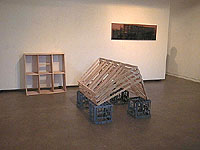|

761m2
Documenting
the social landscape, the often superficial politicking surrounding our
urban social structures and the natural environment has been a central
concern for the visual arts throughout history. Our landscape, the suburban
sprawls mushrooming in our native ‘back yards’, the fluorescence
of stringlines and demarcations beacons of progress and urban conformity
is translated and reconstructed in the current exhibition 761M2.
A constantly shifting viewer/object relationship is implicit in Bevan
Honey’s art practice. The works acquire physical presence through
use of perspective devices and surface textures. The highly polished surfaces
act like mirrors shaping the beginnings of a dialogue between the observer,
the work and the space they both inhabit.
The use of line and wood are pivotal to this new body of work. The correlation
of these two elements is introduced in Split I and Split II. An apple
tree, a typically European colonial symbol, is split in half, re-conjoined
with each half reflected back on itself, to form two distinct images.
By the simple act of deconstructing and reconstructing a single form a
new image is created, as similarly throughout history urban settlements
have attempted to manipulate nature into a contrived copy of itself.
S, SE, E, NE, N, NW, W, SW are rotational views of the artist’s shed
rafters each drawn at 45°angles within a 360° circle. These works
invite us to wrestle with our Australian post-colonial history, with our
personal and collective realities through the use of metaphors, in this
case the humble shed. A suburban icon, on the one hand a symbol of suburban
conformity while on the other a romantic almost sacred place for the DIY
enthusiast, the Eldorado of suburban creativity and fantasy. This duality
is explored through the use of a fixed subject; the shed and a shifting
focus; the artist. Each cardinal point redrawn with a marginal shift in
perspective, remains inevitably recognisable. The use of charcoal, a natural
element is juxtaposed to the industrial inorganic MDF wood. The charcoal
staining enriches the surface but not the subject. The only human element
is the freehand drawing, the hand marks on the surface. The density of
the pigment is loose and thin accentuating a sense of fragility and transience.
The linear framework in Stringlines is made up of 90 horizontal lines
per work forming a sequence of 4 parts, each referencing a cardinal point.
The cardinal directions are important geographic descriptors mapping references
and measurements of location.. The line made using builders’ string
and chalk refers to the customary delineation of our space, the way we
map, cloister, segment and given meaning to our surroundings. Underlying
much of what we do are empirical formulas, data based rationales that
often go against the natural grain. The process of flicking chalk onto
the surface is a measured act yet each action leads to a different result;
geometric precision is coupled with the unknown element of chance and
results in rhythmic but variable surface textures.
This process coupled with the use of an ‘Yves Klein’ blue pigment
infers a rationalisation of the ‘sublime’ or metaphysical, possibly
inferring that our manipulation of the world extends outside our immediate
physical environment.
After the illustration, Instruction I and Illustration form a three way
reading. After the illustration is a metaphorical shelter from belief
systems, conformity and rules of judgement. Sitting on milk crates, still
in kit form it investigates the stretch between the actual and the ideal,
reality and desire. After the illustration relates to the highly polished
Illustration, where the tension between ‘ideal’ and ‘actual’
is exposed. The scaffolded structure bears little resemblance to the construction.
In both cases the scaffolding structure is devoid of any aesthetic or
decorative detail it remains a purely formulated equation. The sequence
of the relational dialogue between the works extends to Illustration.
The ‘real’ illustration hangs distant from the unassembled components
of the cruciform construction.
The exhibition as a whole challenges us to wrestle with the parallels
between an empirical and an actual environment, to investigate the means
by which our western contemporary culture irreverently approaches the
reshaping of our personal and collective realities through the use of
contemporary metaphors.
Paola Anselmi
August
2003
|